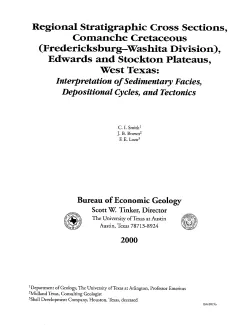
Publication Details
Geolocation:
Get the Publication
$12.00
Abstract/Description:
Six interlocking regional stratigraphic cross sections of Lower Cretaceous strata (middle Albian-lower Cenomanian) of the Edwards and Stockton Plateaus of West Texas illustrate the vertical and lateral extent of lithostratigraphic units and distribution of facies and facies tracts. Facies maps, prepared along selected horizons and thought to represent a brief period of time, and maps illustrating features along critical stratigraphic boundaries are interpreted to illustrate paleoenvironmental distributions through time, as well as stratigraphic relationships. The interval from the top of the Trinity division (cop of the Glen Rose Formation) to the top of the Comanchean Series is considered to be a natural, physically defined stratigraphic division: the Fredericksburg-Washita - containing three subdivisions that define the regional stratigraphic framework. Three and one-half depositional cycles are identified within the lower-middle subdivisions and interpreted in terms of sedimentation, tectonics, and eustasy. The base of the division may be interpreted as a tectonically enhanced type-2 sequence boundary, whereas three other possible boundaries (one in the lower and two in the middle subdivision) would be considered transitional sequence boundaries if they are related to eustatic cycles.